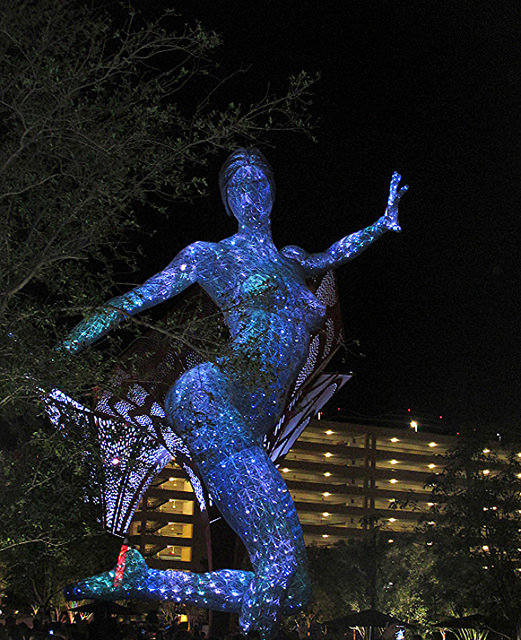
Nature meets urban landscape on the Las Vegas strip with the opening of The Park, an outdoor complex built by MGM Resorts International and sandwiched between Monte Carlo and New York-New York. While it seems like an oxymoron to mention the words park and Las Vegas strip in the same sentence, the park is a place to relax, hang out and dine in a desert landscape that connects visitors and locals to the T-Mobile Arena. While I’ve spent a lot of time finding my zen in many high-end Las Vegas spas, this is the only park I’ve found on all of my visits to sin city and specifically Las Vegas Boulevard. You can really feel nature pulling you in.


As is typical of a painter’s palette, color plays a key role in this ecology-focused park. Fiery reds and flecks of gold color are also characteristic of the Southwestern landscape. Many nature lovers and photographers hold Nevada dear for its iconic natural landmarks like Red Rock Canyon and Valley of Fire, especially when the afternoon light illuminates the area. The meta-quartzite stone used in creating the park’s 600 pieces and planters is a product of similar geology that traces back to the Jurassic Period.
Las Vegas Rocks
With more than 1,000 tons of meta-quartzite stones incorporated into features within The Park, the locally quarried stone is a key component in the surrounding landscape. Made from sandstone native to this area, the stone is found only 30 miles south in the desert foothills of Nevada. I think it’s wonderful that the landscape architects made a significant effort to use locally sourced stone.


With my California perspective of water conservation, I also appreciate the drought tolerant plants interspersed in the pocket park. Much care was given to water conservation in the design of the park, so much so that the Southern Nevada Water Authority presented MGM Resorts’ Chairman and CEO Jim Murren with the Authority’s 2016 Water Hero Award acknowledging The Parks’ commitment to water conservation. Don’t fret about wasted water when you see two 100-foot long water walls in the park. In a nod to water conservation efforts in the Nevada desert, water used throughout The Park, including the water walls, is on a closed-loop system that captures and reuses the water.


Bliss Dance
Working your way toward T-Mobile Arena, one can’t miss Bliss Dance, a 40 foot tall sculpture by San Francisco artist Marco Cochrane. First making her debut at Burning Man in the Nevada desert and then moving on to San Francisco’s Treasure Island, Bliss Dance has found her permanent home at The Park Las Vegas. She makes quite a statement, lighting up at night with 3,000 colored LED lights. What some people may not know is that Bliss Dance is actually modeled after an actual woman, Deja Solis. In Cochrane’s description of this sculpture he notes that it is intended to change perspective. The Bliss Project series is meant to de-objectify women and inspire men and women to take action to end violence against women.


Park dining
Finally, what’s a park without a picnic? The Park Las Vegas is all about dining options. From Beerhaus to Shake Shake, California Pizza Kitchen to Bruxie and Sake Rok, there’s lunch and dinner options for young and old. My personal favorite is Sake Rok, featuring Japanese cuisine and sake, of course. What’s fun about Sake Rok, servers bust out dance moves and lip-sync to top hits like only Las Vegas employees can – it’s fun, fresh and tasty, too!
Insider tip:
I’ll bet you didn’t know that more than 1,000 tons of meta-quartzite stones was incorporated into features of The Park. For additional insider tips follow @nancydbrown on Twitter and @theparkvegas. For active adventure photos follow me on Instagram @nancydbrown as well as @theparkvegas.
If You Go:
The Park Las Vegas, www.theparkvegas.com
Las Vegas, Nevada 89109
Article written by, Bliss Dance video and photos courtesy of Travel Writer Nancy D. Brown of What a Trip, Travels from Northern California. This story first appeared here on Nancydbrown.com.
